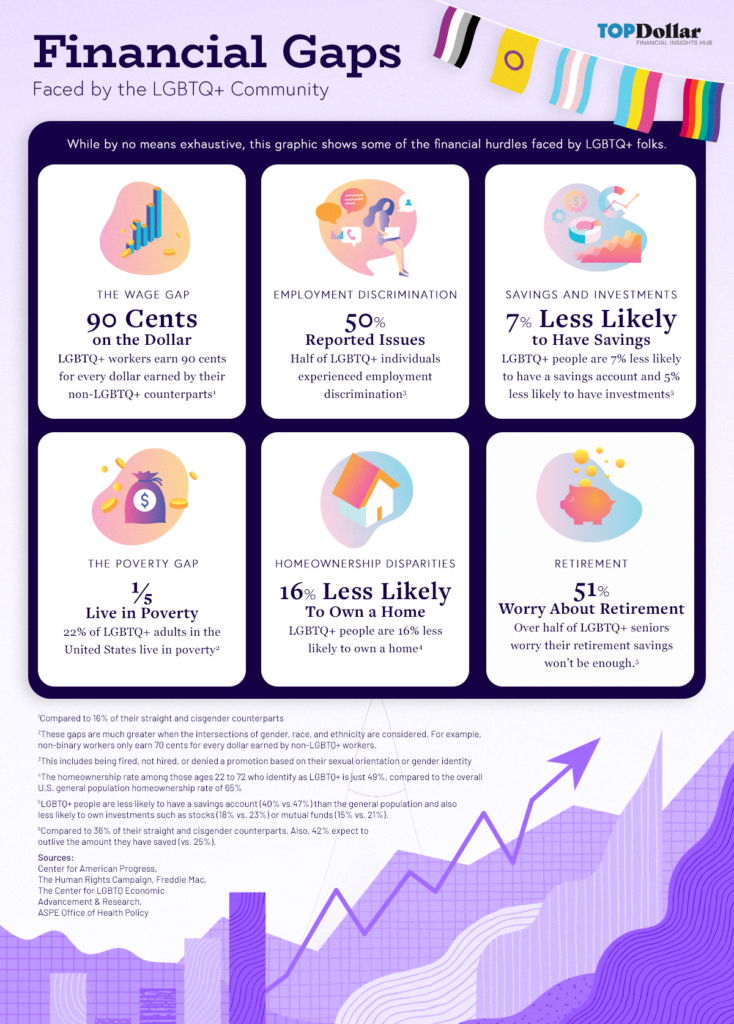Members of the LGBTQ+ community face unique financial challenges and disparities that can significantly impact their economic well-being. From workplace discrimination to the added financial burdens caused by income gaps, healthcare costs, and legal expenses, navigating the financial landscape can be overwhelming. This article features data that demonstrates the financial obstacles experienced within the LGBTQ+ community.
In This Post
- Financial Gaps Faced by LGBTQ+ People
- LGBTQ+ Pay Gap by Gender or Gender Identity
- Pay Gap by Sexual Orientation and Race/Ethnicity
- Other Barriers to Financial Wellness
- Financial Resources for the LGBTQ+ Community

LGBTQ+ Pay Gap by Gender or Gender Identity
The issue of pay inequality within the LGBTQ+ community extends beyond sexual orientation and encompasses disparities based on gender or gender identity as well.
For every dollar earned by non-LGBTQ+ workers, these groups earned:
- 96 cents: LGBTQ+ Men
- 87 cents: LGBTQ+ Women
- 70 cents: Non-Binary, Genderqueer, Genderfluid, and Two-Spirit Workers
- 70 cents: Trans Men
- 60 cents: Trans Women
Pay Gap by Sexual Orientation and Race/Ethnicity
Research shows that LGBTQ+ individuals who are also people of color often experience higher levels of pay disparity compared to their white counterparts. This intersectionality compounds the effects of discrimination and bias, resulting in even wider gaps in wages and opportunities.
For every dollar earned by non-LGBTQ+ workers, these groups earned:
- 97 cents: LGBTQ+ White workers
- 90 cents: LGBTQ+ Latinx
- 80 cents: LGBTQ+ Black workers
- $1.00: LGBTQ+ Asian/Asian Pacific Islanders workers*
- 70 cents: LGBTQ+ Native American workers
This disparity widens at the intersection of race and ethnicity.
*While AAPI workers earn about the same as typical workers, this still represents a disparity. Among all workers in the United States, Asian/Asian Pacific Islander workers reported higher median weekly wages than the typical non-AAPI worker, though it should be noted that there is some nuance to this finding.
Other Barriers to Financial Wellness
LGBTQ+ people reported losing the ability to rely financially on their families after coming out.
While 73% of LGBTQ+ respondents said they could rely financially on their family before telling them about their sexual orientation, only 62% reported being able to rely financially on their family after coming out. The gap is even larger for transgender respondents.
LGBTQ+ respondents reported far lower annual household incomes than adults nationwide.
The majority (57%) of LGBTQ+ people reported a household income of less than $50,000 per year, compared to 36% of adults nationwide. In contrast, only 13% of LGBTQ+ respondents reported an income of $100,000 or more, compared to 34% of adults nationwide.
The LGBTQ+ Economic and Financial (LEAF) Survey
Financial Resources for the LGBTQ+ Community
Experian has put together a list of LGBTQ+-friendly financial resources that serve specific needs and challenges faced by the community, like:
